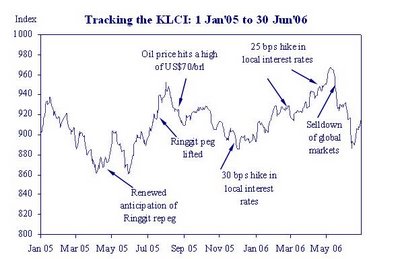KLCI Continues to Ease with Regional Markets
Commencing the month at 930.4 points, the KLCI fell amidst continued declines in regional markets to its year low of 883.2 points in mid-June. However, a rebound in global and regional markets towards the end of June helped the KLCI to close at 914.7 points for a reduced loss of 1.4% for the month of June 2006.
Regional markets closed on a mixed note as concerns of excessive tightening of U.S. monetary policy by the U.S. Federal Reserve diminished. A rebound on Wall Street caused selected regional markets to stem earlier losses in late June. South East Asian markets generally closed weaker while North Asian markets managed to register marginal gains in June.
On Wall Street, the Dow also eased to near its year low of 10,667.4 points in mid-June on concerns of further interest rate hikes before rebounding to 11,150.2 points, down by a marginal 0.2% for the month. The Nasdaq closed 0.3% lower at 2,172.1 points over the same period.











